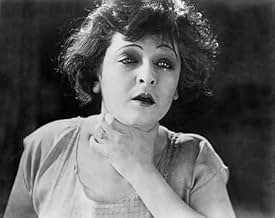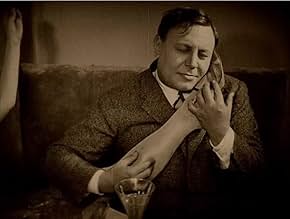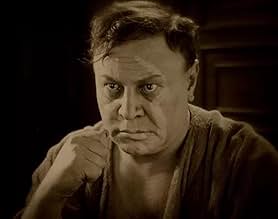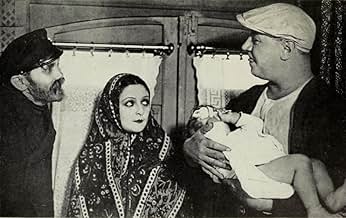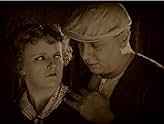PUNTUACIÓN EN IMDb
7,4/10
1,5 mil
TU PUNTUACIÓN
"Boss", quien ha pasado diez años en la cárcel y lleva un espectáculo barato con su mujer, añora su vieja vida de glamour con el circo."Boss", quien ha pasado diez años en la cárcel y lleva un espectáculo barato con su mujer, añora su vieja vida de glamour con el circo."Boss", quien ha pasado diez años en la cárcel y lleva un espectáculo barato con su mujer, añora su vieja vida de glamour con el circo.
- Dirección
- Guión
- Reparto principal
- Premios
- 3 premios en total
The Flying Codonas
- Acrobatic Ensemble
- (as Die Drei Codonas)
Reseñas destacadas
The Plot: Prologue: The murderer "Boss" Huller - after having spent ten years in prison - breaks his silence to tell the warden his story.
"Boss", a former trapeze artist, and his wife own a cheap side-show that displays ''erotic sensations''. But he longs for his former glamorous life in the circus.
When he meets the orphan Berta-Marie, he falls under her spell and leaves his wife and young son behind.
He makes Berta-Marie his partner in a new trapeze number. One day, the famous trapeze artist Artinelli takes note of them and engages them for his trapeze show in Berlin. Their salto mortale becomes an immediate sensation. Calculatedly and cold, Artinelli seduces Berta-Marie and destroys "Boss'" happiness.
If you are watching a version shorter than 112 minutes, you are watching the edited version. My screening was 83 minutes so I know there were lots of scenes cut out.
Still, it's an interesting movie. Yes, the story line is dated, but I assume that was not the case back in 1925.
The direction is really good.
I found interest in watching how people lived back then. Smoking all the time indoors, the luggage used, the different acts at the circus (which, BTW, was not a circus as we know it today, more a vaudeville show).
All the guys wear suits and ties and hats. A different time and place.
Anyway..it's true that the story is not complex. And it's also true that the female lead is not especially attractive. Nor is she slim. And Jannings is laughably overweight to be an acrobat.
The guy who is is stunt double for the acrobat scenes is literally 80 pounds lighter!
Despite all...watch it for the cinematography!
"Boss", a former trapeze artist, and his wife own a cheap side-show that displays ''erotic sensations''. But he longs for his former glamorous life in the circus.
When he meets the orphan Berta-Marie, he falls under her spell and leaves his wife and young son behind.
He makes Berta-Marie his partner in a new trapeze number. One day, the famous trapeze artist Artinelli takes note of them and engages them for his trapeze show in Berlin. Their salto mortale becomes an immediate sensation. Calculatedly and cold, Artinelli seduces Berta-Marie and destroys "Boss'" happiness.
If you are watching a version shorter than 112 minutes, you are watching the edited version. My screening was 83 minutes so I know there were lots of scenes cut out.
Still, it's an interesting movie. Yes, the story line is dated, but I assume that was not the case back in 1925.
The direction is really good.
I found interest in watching how people lived back then. Smoking all the time indoors, the luggage used, the different acts at the circus (which, BTW, was not a circus as we know it today, more a vaudeville show).
All the guys wear suits and ties and hats. A different time and place.
Anyway..it's true that the story is not complex. And it's also true that the female lead is not especially attractive. Nor is she slim. And Jannings is laughably overweight to be an acrobat.
The guy who is is stunt double for the acrobat scenes is literally 80 pounds lighter!
Despite all...watch it for the cinematography!
We are privileged that technology allows us to view such films as this, that are almost 100 years old, in such clarity. The print now available on Blu-ray is stunning and even if, after the first few minutes, one becomes used to this, when the setting switches to Berlin nighttime street scenes, our jaw drops again. Vintage photographs of amazing clarity come alive as buses, taxis and crowds of people jostle as the neon shines brightly in the sky. The vaudeville scenes of the 'Codonas', standing in for our film stars, fly through the air with the greatest of ease and demonstrate their infamous 'triple somersault' with only the excited crowd below. Throughout the film there are wondrous shots of the streets, the circus, the fairground and more intimate cabaret, but also there is a tale to be told. Emil Jannings is our star, seemingly too old for the part and looking more like a builder or truck driver than a trapeze 'catcher' but he was such a popular performer back in the stage and silent film days in Germany, this slight oddity would have gone unnoticed. Even more noticeable is the beautifully strange Lay De Putti who plays the love interest here. or should I say, 'sex interest' for this is a surprisingly saucy and frank portrayal of the natural and obvious appeal of such a young and pretty and half naked dancer and trapeze artiste. Not over long, remarkably involving and most fascinating glimpse into the 'variete' scene in 20s Berlin.
The male flyer initially appears in cinema as a flawed hero. The prototypes are characters found in Variety (1925), directed by Ewald Dupont and based on Felix Hollaender's novel, The Oath of Stephen Huller.
This is a semi-expressionist film about a heavy-bodied catcher-husband, Boss Huller (Emil Jannings), whose wife, Bertha-Marie (Lya de Putti), is seduced from domestic bliss by the trio's lighter-bodied star flyer, Artinelli (Warwick Ward). The cather-husband imagines dropping his rival, the flyer, but murders him instead in a fight, and goes to prison. The seducing male flyer is the provocateur of extreme passion, a position subsumed by female aerialist characters in later films. But the male aerialist as a criminal, even murderer, intermittently reappears in representation because he epitomizes a capacity for extreme risk-taking, which is translated into socially risky immoral behavior. But it is the male flyer who becomes especially vulnerable to depiction as a fallen hero, literally and for losing emotional control.
Although little-known today, Variety is one of the major works of German Expressionism. It's an immorality of emotion drama with a fine performance by (the always great) Jannings and the wonderful visual film-making that is the hallmark of the Expressionist movement (extraordinary cinematography by Karl Freund). Variety was heavily censored for its American release; how it was changed makes it almost as interesting as a case study in film censorship as it is enjoyable as a movie.
In its original version, the film begins with a drawn-out portion showing how Emil Jannings falls in love with Lya De Putti, left his wife for her, and created a trapeze act with his lover. This part of the story was excised completely by the American censors, and title cards added to redefine Jannings and De Putti as the married couple of the U.S. release version. The censors' intent was to erase the plot point of casting adulterous lovers as the established couple in a love triangle. The effect was to far more radically transform the story. The unfaithful husband who is in his turn betrayed by his unfaithful lover is transformed into a sympathetic cuckold. The opportunistic temptress who catches two men only to end up with none is transformed into a young wife who succumbs to temptation. From unsparing morality play to conventional melodrama, courtesy of censorship.
This is a semi-expressionist film about a heavy-bodied catcher-husband, Boss Huller (Emil Jannings), whose wife, Bertha-Marie (Lya de Putti), is seduced from domestic bliss by the trio's lighter-bodied star flyer, Artinelli (Warwick Ward). The cather-husband imagines dropping his rival, the flyer, but murders him instead in a fight, and goes to prison. The seducing male flyer is the provocateur of extreme passion, a position subsumed by female aerialist characters in later films. But the male aerialist as a criminal, even murderer, intermittently reappears in representation because he epitomizes a capacity for extreme risk-taking, which is translated into socially risky immoral behavior. But it is the male flyer who becomes especially vulnerable to depiction as a fallen hero, literally and for losing emotional control.
Although little-known today, Variety is one of the major works of German Expressionism. It's an immorality of emotion drama with a fine performance by (the always great) Jannings and the wonderful visual film-making that is the hallmark of the Expressionist movement (extraordinary cinematography by Karl Freund). Variety was heavily censored for its American release; how it was changed makes it almost as interesting as a case study in film censorship as it is enjoyable as a movie.
In its original version, the film begins with a drawn-out portion showing how Emil Jannings falls in love with Lya De Putti, left his wife for her, and created a trapeze act with his lover. This part of the story was excised completely by the American censors, and title cards added to redefine Jannings and De Putti as the married couple of the U.S. release version. The censors' intent was to erase the plot point of casting adulterous lovers as the established couple in a love triangle. The effect was to far more radically transform the story. The unfaithful husband who is in his turn betrayed by his unfaithful lover is transformed into a sympathetic cuckold. The opportunistic temptress who catches two men only to end up with none is transformed into a young wife who succumbs to temptation. From unsparing morality play to conventional melodrama, courtesy of censorship.
As the name already indicates "Variety" is situated in a vaudeville setting. It is about trapeze artists who regularly change partners (both in business and in love). Emil Jannings plays a man who leaves his wife for a younger woman but gets very jealous when he is at risk of receiving the same treatment.
The film portrays the decadence of the roaring twenties in Germany. See for example the scene in which the artists have their own afterparty after the show.
The story however is somewhat flawed. The Emil Jannings character has the possibility to take revenge in a way that looks like an accident. Why he does not choose to do so remains unclear.
Above all "Variety" has earned his place in film history due to the dynamic camera movements during the trapeze scenes. In this way the film is more a cinematographer's film than a director's film. Especially Karl Freund would remain a leading cinematographer in decades to come.
The film portrays the decadence of the roaring twenties in Germany. See for example the scene in which the artists have their own afterparty after the show.
The story however is somewhat flawed. The Emil Jannings character has the possibility to take revenge in a way that looks like an accident. Why he does not choose to do so remains unclear.
Above all "Variety" has earned his place in film history due to the dynamic camera movements during the trapeze scenes. In this way the film is more a cinematographer's film than a director's film. Especially Karl Freund would remain a leading cinematographer in decades to come.
Variete is a well-directed and well-acted morality play. Chock full of cynical humor and ironic twists, it keeps your attention throughout in expert fashion until the last 20 minutes of the movie. Then things unravel too quickly and too obviously to hit home with the intended impact of the final irony. Still, I give it 7 out of 10.
¿Sabías que...?
- CuriosidadesAmerican humorist S. J. Perelman was so taken with this movie he wrote about it 40 years later in an essay entitled "And, in the Center Ring, That Stupendous Death-Defying Daredevil..." He said "Alfredo Cordona, the wizard of the flying rings, and his partners doubled for the actors. I saw the picture four times, reacting so volcanically to Cordona's forward triple somersault that I almost rent the chair in front of me to matchwood."
- ConexionesEdited into Prisoner of Paradise (2002)
Selecciones populares
Inicia sesión para calificar y añadir a tu lista para recibir recomendaciones personalizadas
Detalles
Taquilla
- Recaudación en Estados Unidos y Canadá
- 709.613 US$
- Duración1 hora 44 minutos
- Mezcla de sonido
- Relación de aspecto
- 1.33 : 1
Contribuir a esta página
Sugerir un cambio o añadir el contenido que falta




